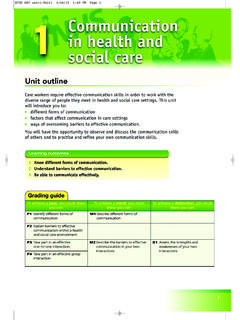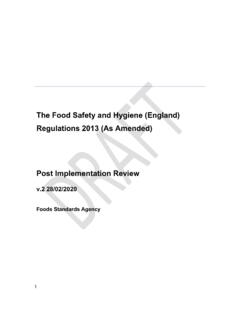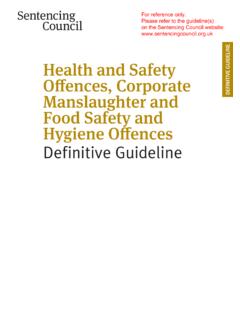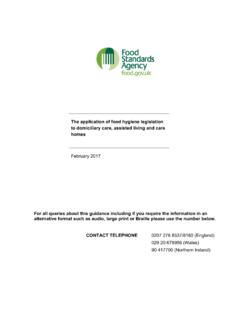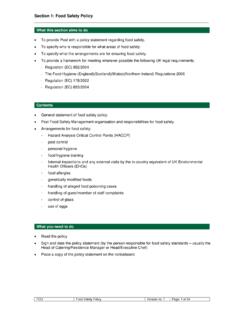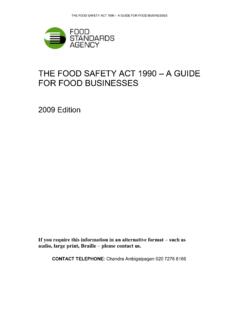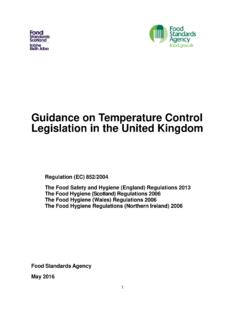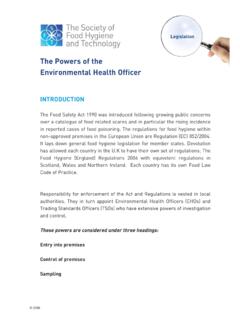Transcription of Health and safety practice in early years settings
1 UNIT 41151144 Health and safety practice in early years settingsLearning aim A1: Understand the importance of complying with relevant Health and safety legislation and regulations Legal requirements for early years settings Health and safety practice in early years settingsLearning aim A2: Understand how to prevent the spread of infection How infection spreads Infection control in an early years settingLearning aim B: Understand how to prevent accidents and incidents and carry out risk assessments Common hazards and how to prevent accidents, incidents and injuries Supervision and resources to prevent accidents Carrying out risk assessmentsLearning aim C: Understand how to respond to emergencies Procedures for responding to accidents Procedures for responding to other emergencies175158 BTEC National 114-11518/01/13 3:29 PM117 Health and safety practice in early years settingsUNIT 4116 Legal requirements for early years settingsLegal requirements for practitionersUnderstanding and complying with Health and safety legislation is one of the most important aspects of working with young children.
2 Parents and carers need to know that their children will be safe in your care and you are legally obliged to follow the guidance set out in Health and safety regulations . Young children are very vulnerable and depend on you to keep them safe from harm. It is therefore very important to have a sound working knowledge of the legal requirements for Health and and safety legislationThe law relating to Health and safety varies in the four home countries of the UK and it is important that you are familiar with the relevant legislation for the country in which you work. The Health and safety legislation for all four countries includes guidance for practitioners relating to: promoting the good Health of children by preventing accidents and dealing with emergencies preventing the spread of infection by maintaining strict hygiene practices and infection control procedures carrying out risk assessments and maintaining a safe, secure environment, both indoors and outdoors keeping up to date with legislation relating to Health and safety and undertaking regular of the main legislation and regulations relating to Health and safety are summarised in Figure Health and safety legislation relevant to early years settingsLegislationImpact on early years practiceThe Health and safety at Work Act 1974 (Great Britain)The Health and safety at Work (Northern Ireland)
3 Order 1978 Outlines the responsibility of individual employees for maintaining Health and safety in the Act 2006 Focuses on improving outcomes for children in the early years through the five outcomes of Every Child Matters (including being healthy and staying safe ).Introduced the early years Foundation Stage in 2008 (including the welfare requirements for promoting Health and safeguarding children).Manual Handling Operations regulations 1992 Provides guidance for lifting and carrying children, including correct techniques and procedures for risk of Substances Hazardous to Health regulations 2002 (COSHH) Protects children from dangerous chemicals (including cleaning substances and medicines), including regulations about storage and of Injuries, Diseases and Dangerous Occurrences regulations 1995 (RIDDOR)Outlines the procedures for reporting accidents, injuries and infectious diseases such as TB and meningitis to the Health and safety Executive (HSE) and the Health Protection Agency (HPA).
4 The food hygiene ( england ) regulations 2006 (similar legislation in Scotland, Wales and Northern england )Provides guidance on the preparation, storage and cooking of food and the requirements for staff training in food Framework for the early years Foundation Stage 2012 ( england )The safeguarding and welfare requirements outline the legal responsibilities for providers in promoting children s Health , safety and wellbeing (ages 0 5 years ).Organisation of the environmentThe statutory safeguarding and welfare guidance in the early years Foundation Stage (2012) include the legal requirements for organising the setting in order to meet the Health and safety needs of children from birth to five years old. In registered settings , the indoor premises must be large enough for the number of children in the setting. The provider must also ensure that, so far as is reasonable: the facilities, equipment and access to the premises are suitable for children with disabilities there are suitable hygienic facilities for changing any children who are in nappies there is an adequate number of toilets and hand basins to this unitParents want their children to be safe and well when they leave them in someone else s care.
5 They also need reassurance that early years practitioners know exactly what to do in the event of an emergency. In this unit, you will learn about preventing the spread of infection and how to deal with emergencies in an early years setting. You will also learn how to create safe environments, both indoors and outdoors, while still allowing children to explore and take risks. The knowledge from this unit provides an introduction to a paediatric first aid course, which is required for work in most termsHealth and safety Executive (HSE): national independent watchdog for work- related Health and safety issuesHealth Protection Agency (HPA): the organisation responsible for protecting public healthIt is important for practitioners to have a sound working knowledge of Health and safety legislationYour assessment criteria:Learning aim A 1: Understand the importance of complying with relevant Health and safety legislation and regulations P1 Describe how legal requirements affect practice in early years settings using examples relevant to the home country: to promote the good Health of children to prevent the spread of infection for risk assessment for organisation of the environment.
6 M1 Discuss reasons why early years settings must comply with legal requirements for Health and the safeguarding and welfare requirements of the early years Foundation Stage 2012. Reflect on how it affects your practice in placement and make a list of some of the reasons why it is important to comply with the legal requirements in the following areas: promoting children s good Health preventing the spread of infection organisation of the environment in your BTEC National 116-11718/01/13 3:29 PM119 Health and safety practice in early years settingsUNIT 4118 Health and safety practice in early years settingsProfessional practiceExampleWear protective clothing when aprons and disposable gloves when changing accidents, incidents, injuries and accident the relevant with parents and carers when with legislationAs an early years practitioner, it is your responsibility to understand how Health and safety legislation applies to your own practice in the workplace setting.
7 Complying with Health and safety legislation is extremely important in order to: protect children, staff and other from accidents, injuries and illness promote children s Health and wellbeing provide reassurance for parents and carers and inspire their confidence in the setting maintain a safe working environment for children, staff and visitors meet the requirements for registration with Ofsted (the Office for Standards in Education) in england or other regulatory organisations: Estyn in Wales, Education and Training Inspectorate in Northern Ireland and Education practiceYou will need to undertake regular training in areas such as first aid and food hygiene and will also be responsible for keeping up to date with changes in legislation and regulations . Some aspects of professional practice in Health and safety are summarised in Figure assessment criteria:Learning aim A 1: Understand the importance of complying with relevant Health and safety legislation and regulations P1 Describe how legal requirements affect practice in early years settings using examples relevant to the home country: to promote the good Health of children to prevent the spread of infection for risk assessment for organisation of the environment.
8 M1 Discuss reasons why early years settings must comply with legal requirements for Health and safety . D1 Assess the ways in which legislation and procedures in early years settings contribute to children s Health and termRegulatory: having authority and responsibility to enforce regulationsFigure Professional practice in Health and safetyProfessional practiceExampleTake care of your own Health and lifting heavy objects on your own or without the appropriate Health and safety policies and procedures in the the emergency procedures for fire and evacuation of the fire exits sure that medicines and other harmful substances are stored strict hygiene strict hygiene practices when preparing food or drinks for children and when carrying out toileting or nappy changing the cleanliness of the environment, toys and play risk the safety of the environment, equipment and play risks for planned activities and children to follow Health and safety procedures and hygiene out regular hand washing the safe use of toys and play and safety informationThere are many organisations that provide information and guidance on all aspects of Health and safety .
9 These include: Health Protection Agency (HPA): an organisation responsible for protecting public Health through the provision of support and advice to the National Health Service, local authorities, emergency services and the Department of Health Health and safety Executive (HSE): a national independent watchdog for work- related Health and safety issues, responsible for acting in the public interest to reduce work- related death and serious injury food Standards Agency (FSA): an independent government department responsible for food safety and food hygiene across the UK British safety Council: a UK charity that works with businesses to improve their Health , safety and environmental management Child Accident Prevention Trust (CAPT): a UK charity working to reduce the number of children killed, disabled or seriously injured In studyCheryl has just been promoted to the position of deputy manager at Little Rascals Day Nursery, a registered setting that provides places for children aged six months to five years .
10 The manager has asked Cheryl to review and update the Health and safety policies at the Describe the Health and safety policies you would expect to be in place at Little Rascals Day Explain why it is important for early years settings to review and update their Health and safety policies on a regular List some of the Health and safety organisations that Cheryl might consult, and give examples of the information she might obtain from each the procedures in your placement or workplace setting for: reporting accidents and notifying childhood illnesses food hygiene procedures when preparing snacks for children storage of medicines and cleaning additional information from the Health and safety Executive ( ), create a Health and safety report that explains the ways in which these procedures contribute to children s Health and one of the organisations listed in this section. Design an information leaflet or web page for new employees, providing guidance on the work of the organisation you have follow hygiene guidelines when changing nappies175158 BTEC National 118-11918/01/13 3:29 PM121 Health and safety practice in early years settingsUNIT 4120 How infection spreadsPreventing the spread of infectionYoung children are vulnerable to infection, as their immune systems are still developing.


